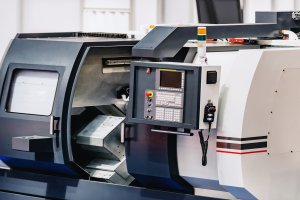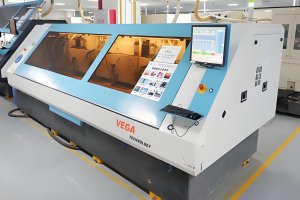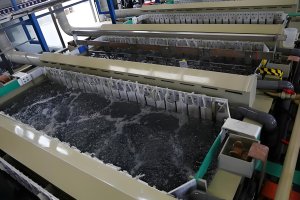Waterjet cutting stands as a testament to the marvels of modern manufacturing. This innovative technology harnesses the power of high-pressure water streams to slice through a wide array of materials with incredible precision. Unlike other cutting methods that generate heat, waterjet cutting maintains the structural integrity of materials by using a cold cutting process. Let’s delve into the details of this remarkable technology, its components, types, and the diverse applications across various industries.
Understanding Waterjet Cutting
Waterjet cutting utilizes a computer-controlled (CNC) machine equipped with specialized software to direct the movement of the cutting head. This software ensures precise cuts on various materials without introducing heat, making it ideal for applications that require meticulous detail. The process can be categorized into two main types: Pure Waterjet Cutting and Abrasive Waterjet Cutting.
Pure Waterjet Cutting
Pure waterjet cutting uses only high-pressure water to cut softer materials like plastics, rubber, foam, and textiles. This method is particularly effective for applications that demand hygiene and temperature sensitivity, such as food processing. The high-speed water jet cleanly cuts materials without the need for abrasives.
Advantages of Pure Waterjet Cutting:
- Low cutting force
- No heat generation
- Hygienic for food and medical applications
- Precision in cutting soft materials
Disadvantages:
- Not suitable for hard materials like metals and ceramics
Abrasive Waterjet Cutting
For tougher materials such as metals, stones, and ceramics, abrasive waterjet cutting is employed. This method involves mixing abrasive particles, like garnet, with high-pressure water to enhance cutting power. The mixture exits through a nozzle, creating a potent stream capable of cutting through hard surfaces.
Advantages of Abrasive Waterjet Cutting:
- Cuts a wide range of materials
- High precision with narrow kerf
- Minimal mechanical stress on materials
- No heat-affected zones
Disadvantages:
- Higher operational costs due to abrasives
- Requires proper disposal of used abrasives
Key Components of Waterjet Cutting Systems
The efficiency and precision of waterjet cutting are attributed to its well-engineered components:
High-Pressure Pump
The high-pressure pump is the heart of the waterjet system, generating the necessary pressure for cutting. There are two types of pumps: direct drive pumps and intensifier pumps. Direct drive pumps operate similarly to household washing decks, delivering pressures between 20,000 and 50,000 psi. Intensifier pumps, on the other hand, can boost pressure up to 55,000 psi, enabling efficient cutting of hard materials.
Abrasive Delivery System
This system controls the ratio of abrasive to water, which varies depending on the material being cut. The metering device ensures the precise delivery of abrasives to the cutting head, enhancing cutting efficiency.
Cutting Head
The cutting head includes a jewel orifice, usually made of sapphire or diamond, where pressurized water converts into a high-velocity stream. The Venturi chamber and mixing tube further refine the mixture of water and abrasives, creating a powerful cutting stream.
Motion Equipment
The CNC system drives the cutting head over the workpiece using an X-Y axis movement mechanism. This allows for precise cuts and easy access to the cutting surface, enhancing the flexibility and efficiency of the waterjet cutter.
Control Software
The CNC software, often designed in AutoCAD, converts design files into numerical instructions for the cutting machine. This automation ensures consistent precision and accuracy in cutting complex shapes and designs.
Types of Waterjet Cutting Machines
Waterjet cutting machines vary in complexity and capabilities, accommodating different cutting requirements:
One-Dimensional (1D)
Ideal for straight or linear cuts, the 1D waterjet cutter moves in a single direction and is often used for trimming edges.
Two-Dimensional (2D)
The 2D cutter operates on the X-Y axis, enabling both linear and circular cuts. It is widely used in industries such as agriculture, mining, and aerospace for its efficiency and accuracy.
Three-Dimensional (3D)
The 3D cutter moves along the X, Y, and Z axes, providing high dynamic capacity and precision for complex shapes.
Four-Dimensional (4D)
The 4D cutter includes a rotary motion around the X-axis, allowing for curved cuts and machining five sides of a material.
Five-Dimensional (5D)
The 5D cutter executes linear, rotary, and inclined cuts, making it versatile for 2D and 3D applications in aerospace, automotive, and decorative industries.
Applications of Waterjet Cutting
Waterjet cutting’s versatility makes it indispensable across numerous industries:
Architectural Industry
Waterjet cutting processes materials like metals, plastics, and wood to create intricate architectural designs, signage, and decorative panels.
Automotive Industry
The high-speed cutting capabilities of waterjet technology enable rapid prototyping and customization of vehicle parts, including aluminum and carbon fiber components.
Aerospace Industry
Waterjet cutters handle rigid aerospace materials with high precision, ensuring safety and performance in aircraft components like fuselages and turbines.
Electronics Industry
The precision of waterjet cutting is ideal for manufacturing electronic components, including semiconductor wafers, circuit boards, and device enclosures.
Food Processing Industry
USDA-approved pure waterjet cutting offers hygienic and precise cutting of food products, reducing waste and ensuring clean edges.
Manufacturing Industry
Waterjet technology accelerates production and eliminates the need for secondary finishing, producing items like sheet metal patterns and complex shapes.
Medical and Surgical Equipment
The precision of waterjet cutting benefits the medical industry by crafting surgical instruments from materials like titanium and stainless steel, ensuring tight tolerances and high-quality finishes.
Advantages of Waterjet Cutting
Extreme Accuracy
Waterjet cutting achieves a precision of +/- 0.0003 to 0.0005 inches, making it ideal for applications requiring tight tolerances.
Environmental Benefits
Waterjet cutting is an eco-friendly process, utilizing water and natural abrasives without emitting harmful fumes or generating hazardous waste.
No Heat-Affected Zones
The cold cutting process of waterjet technology prevents material deformation and maintains the integrity of the cut edges.
Minimal Material Waste
The narrow cutting stream and precise control reduce material waste, making waterjet cutting cost-effective and efficient.
No Secondary Finishing Required
Waterjet cutting produces clean edges, eliminating the need for additional finishing processes and saving time and resources.
Future of Waterjet Cutting
As technology continues to advance, waterjet cutting machines are becoming more compact, efficient, and versatile. Researchers and manufacturers are constantly improving the capabilities of waterjet cutters, making them suitable for an even broader range of applications. The future of waterjet cutting promises further innovations, enhancing its role as a vital tool in modern manufacturing.
Waterjet cutting stands as a pinnacle of precision and versatility in the manufacturing world. Its ability to cut through a wide variety of materials with unmatched accuracy, without generating heat or mechanical stress, makes it an invaluable asset across multiple industries. As technology evolves, waterjet cutting will continue to revolutionize the way we approach cutting and shaping materials, ensuring that it remains at the forefront of modern manufacturing techniques.
Other Articles You Might Enjoy
- Introduction to Precision Parts Machining: Cutting and Special Processes
Precision parts cutting machining primarily includes precision turning, mirror grinding, and lapping. Using finely ground single-crystal diamond tools on precision lathes, ultra-fine turning is performed with a cutting thickness of…
- Introduction to Waterjet Cutting : Operation Process, Key Advantages, and Industry Applications
Introduction to Waterjet Cutting Waterjet cutting is a versatile and precise material-cutting process that utilizes a high-pressure jet of water, often combined with an abrasive substance, to slice through various…
- Masterful Precision: Elevating Aluminum Craftsmanship with Laser Cutting
Laser cutting penetrates and slices through materials with a high-powered laser beam guided by CNC (Computer Numerical Control). The process achieves high-precision cuts, intricate detail work, and polished edges on…
- Comprehensive Guide to Metal Cutting Tools
In modern mechanical manufacturing, metal cutting processes are the most widely used methods, accounting for over 50% of the total workload in mechanical manufacturing. Whether it's a conventional lathe, an…
- Laser Cutting Aluminum: Transforming Aluminum into Perfection
Laser Cutting Aluminum: An Introduction The process of laser cutting aluminum is a potent technology integral to the manufacturing sector. It involves focusing concentrated beams of laser light on an…
- Laser Cutting Materials: MDF vs. Plywood - What's Best for Your Project?
Introduction to MDF and Plywood in Laser Cutting In the world of laser cutting materials, Medium Density Fibreboard (MDF) and plywood are commonly used resources. These two materials offer unique…






